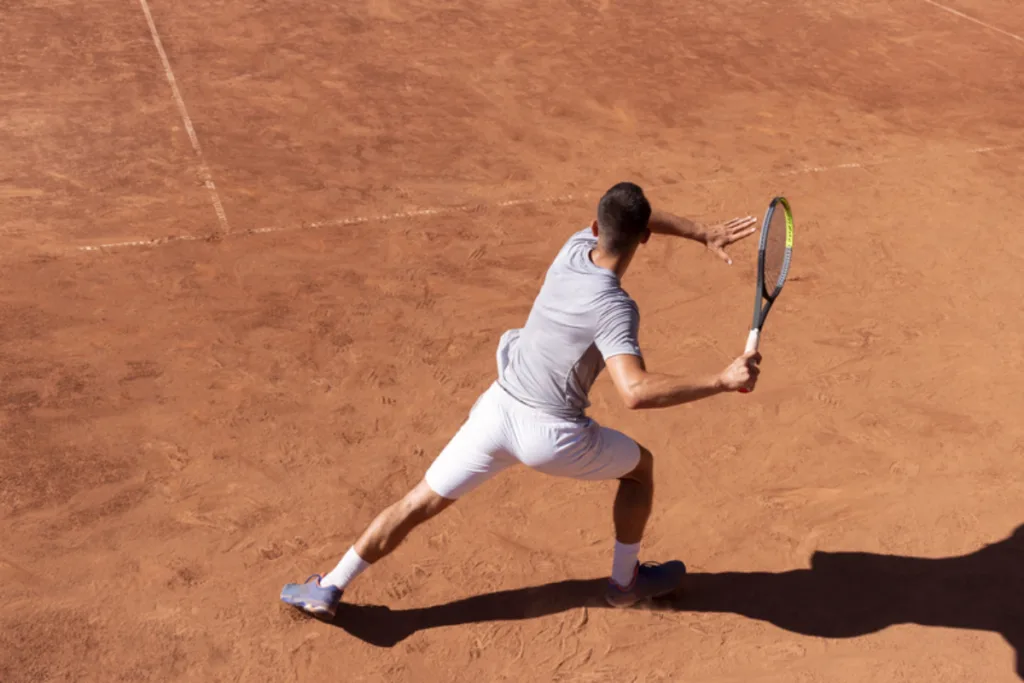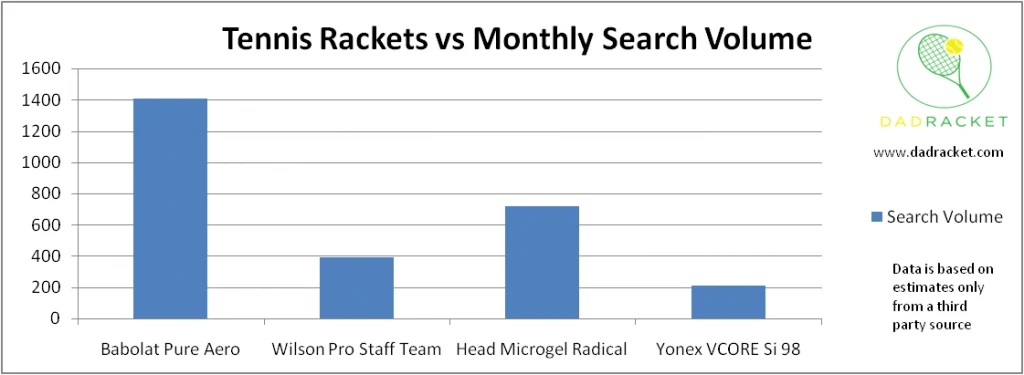
If you feel your game has improved, and you’re ready for the next step, you might want to consider purchasing a racket that will give you a bit more control.
Here are 5 rackets which are great choices if you play to a fairly good standard (Intermediate). I’ll look at the pros and cons of all these options in this article
- Babolat Pure Aero
- Wilson Pro Staff Team
- Head Microgel Radical
- Yonex VCORE Si 98 Lite
- Mantis Pro 295 III
How Do You Choose An Intermediate Tennis Racket?
There aren’t a lot of fundamental differences between rackets for beginner and intermediate players.
A beginner racket will usually give you more power, be a touch lighter to hold, but you will have less control on your shots.
A racket for an intermediate player might generate slightly less power, but on the upside you get more control, which is great for drop shots, volleys and more consistent ground strokes.
Here are some other factors to bear in mind:
Head Size
Beginner tennis rackets will have larger head sizes, but for an intermediate racket look for a smaller head size, somewhere around 95-100 square inches. This is what helps you get more control in your game.
Make sure you’re ready for the step to an intermediate racket. If you hit the frame a lot with a larger head sized racket, you will undoubtedly struggle with a smaller head size. You should be able to time your shots well with good footwork.
Grip Size
Ideally, you should measure your grip size to get it just right for you.
If it’s too small, then you may have some wrist and elbow problems. But overall there shouldn’t be a fundamental difference between your grip for a beginner, intermediate or professional tennis racket.
Weight
You probably want a light to mid weight racket if you’re an intermediate player. Professional rackets are usually heavier, which can give you more power, but unless you are really well conditioned and strong, you will get tired very quickly.
So choose something which is not too light, but not too heavy either, something between 280-310 grams.
Ideally, you want the heaviest racket you can manage comfortably, as having a racket which is too light, can cause injury problems if you start swinging too quickly with it.
–
With these factors in mind, here are some tennis rackets to take your game to the next level.
1. Babolat Pure Aero
- Weight: 300g
- Head Size: 100 square inches

Pros
- Good for adding more power to your game
- Adds more control to your shots
- Generate a lot of topspin on your ground strokes.
- Integrated Cortex system helps to dampen vibrations and lessen injuries.
- Great for baseline rallies, and digging yourself out of tricky situations.
Cons
- Doesn’t really suit serve and volley players, not as manoeuvrable around the net.
2. Wilson Pro Staff Team
- Weight: 295g
- Head Size: 100 square inches

Pros
- Good balance and weight to the racket
- Easy to swing faster to generate power
- Very comfortable at contact with good feel
- Good for the all-round tennis player.
Cons
- Some players dislike the strings which it comes with. You may wish to restring it if you find you lose some distance control on your groundstrokes
3. Head MicroGel Radical
- Weight: 295g
- Head Size: 98 square inches.

Pros
- Great control for all types of shots
- Microgel technology helps to absorb shock and give you more comfort when playing.
Cons
- Doesn’t produce much power, so you’ll need fast groundstrokes.
4. Yonex VCORE 98 Lite
- Weight: 285g
- Head Size: 98 square inches.

Pros
- Frame uses Aerofin technology to help with your swing
- Good racket stiffness to give players more power
- Hybrid stringing system helps to generate more spin on the ball
Cons
- It’s on the lighter side for an intermediate racket, which might be an issue for some players, especially those who like to swing fast and generate their own power.
5. Mantis Pro 295 III
- Weight: 295g
- Head Size: 98 square inches.

Pros
- Excellent control, especially round the net and for volleys
- Great for generating topspin on your shot.
- A good all round racket.
Cons
- Although it does pack a punch when you hit the sweetspot, it isn’t the best racket for long baseline rallies.
Which Is The Most Popular Intermediate Level Racket?
Here is a chart which shows the monthly search volume for each of these tennis rackets.
Unfortunately my tennis racket shows a big fat ‘0’ when I looked at the search volume. That’s not surprising as Mantis is not as well known as the other tennis brands, particularly in the US.
Also I looked at the Yonex VCORE Si 98 in general, not just the ‘Lite’ version, as I thought that was a fairer comparison with the other tennis rackets.

The Bottom Line
There are a lot of good choices here and you probably can’t go wrong with any of them.
However, as you can see there are some subtle differences between all of them and your playing style will likely determine what you should choose in the end.
If you are a baseline player than the Babolat Pure Aero would be the best choice.
If you like to come to the net more often and hit volleys and dropshots, then the Head Microgel.
For an overall racket, the Wilson Pro Staff seems to offer a good balance for all aspects of the tennis game.
